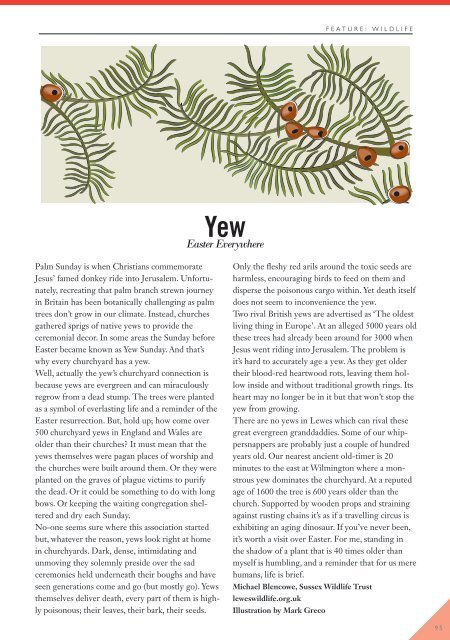Viva Lewes April 2015 Issue #103
Create successful ePaper yourself
Turn your PDF publications into a flip-book with our unique Google optimized e-Paper software.
feature: wildlife<br />
Yew<br />
Easter Everywhere<br />
Palm Sunday is when Christians commemorate<br />
Jesus’ famed donkey ride into Jerusalem. Unfortunately,<br />
recreating that palm branch strewn journey<br />
in Britain has been botanically challenging as palm<br />
trees don’t grow in our climate. Instead, churches<br />
gathered sprigs of native yews to provide the<br />
ceremonial decor. In some areas the Sunday before<br />
Easter became known as Yew Sunday. And that’s<br />
why every churchyard has a yew.<br />
Well, actually the yew’s churchyard connection is<br />
because yews are evergreen and can miraculously<br />
regrow from a dead stump. The trees were planted<br />
as a symbol of everlasting life and a reminder of the<br />
Easter resurrection. But, hold up; how come over<br />
500 churchyard yews in England and Wales are<br />
older than their churches? It must mean that the<br />
yews themselves were pagan places of worship and<br />
the churches were built around them. Or they were<br />
planted on the graves of plague victims to purify<br />
the dead. Or it could be something to do with long<br />
bows. Or keeping the waiting congregation sheltered<br />
and dry each Sunday.<br />
No-one seems sure where this association started<br />
but, whatever the reason, yews look right at home<br />
in churchyards. Dark, dense, intimidating and<br />
unmoving they solemnly preside over the sad<br />
ceremonies held underneath their boughs and have<br />
seen generations come and go (but mostly go). Yews<br />
themselves deliver death, every part of them is highly<br />
poisonous; their leaves, their bark, their seeds.<br />
Only the fleshy red arils around the toxic seeds are<br />
harmless, encouraging birds to feed on them and<br />
disperse the poisonous cargo within. Yet death itself<br />
does not seem to inconvenience the yew.<br />
Two rival British yews are advertised as ‘The oldest<br />
living thing in Europe’. At an alleged 5000 years old<br />
these trees had already been around for 3000 when<br />
Jesus went riding into Jerusalem. The problem is<br />
it’s hard to accurately age a yew. As they get older<br />
their blood-red heartwood rots, leaving them hollow<br />
inside and without traditional growth rings. Its<br />
heart may no longer be in it but that won’t stop the<br />
yew from growing.<br />
There are no yews in <strong>Lewes</strong> which can rival these<br />
great evergreen granddaddies. Some of our whippersnappers<br />
are probably just a couple of hundred<br />
years old. Our nearest ancient old-timer is 20<br />
minutes to the east at Wilmington where a monstrous<br />
yew dominates the churchyard. At a reputed<br />
age of 1600 the tree is 600 years older than the<br />
church. Supported by wooden props and straining<br />
against rusting chains it’s as if a travelling circus is<br />
exhibiting an aging dinosaur. If you’ve never been,<br />
it’s worth a visit over Easter. For me, standing in<br />
the shadow of a plant that is 40 times older than<br />
myself is humbling, and a reminder that for us mere<br />
humans, life is brief.<br />
Michael Blencowe, Sussex Wildlife Trust<br />
leweswildlife.org.uk<br />
Illustration by Mark Greco<br />
95


















